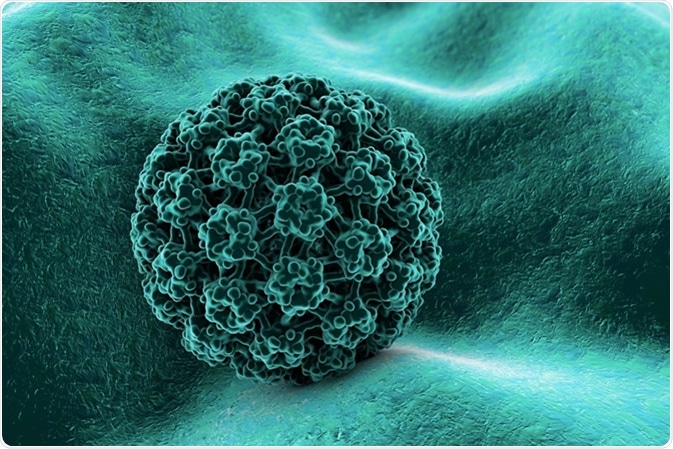High-risk types of human papilloma virus (HPV) are one of the most important risk factor for cervical carcinomas in women. Conventionally, pap smear cytology and PCR have been used to screen for the presence of HPV. Recently, a new commercial HPV test has been proposed for diagnosis of HPV-Hybrid capture assay.

Background with virus. Human papillomavirus on the surface of a cell. A model is built using data of viral macromolecular structure from Protein Data Bank (PDB 3J6R). Image Credit: Kateryna Kon / Shutterstock
Principle of Hybrid Capture (HC) HPV Detection
This assay uses a nucleic acid hybridisation assay where the samples with the target DNA hybridize with a HPV RNA probe. The RNA-DNA hybrids are then captured using a microplate which is coated with antibodies for DNA-RNA hybrids. These are then detected using chemiluminescence. Antibodies conjugated with alkaline phosphate and specific for DNA-RNA hybrids react with hybrids which are then subsequently detected using a chemiluminescent substrate. The signal amplification occurs as several conjugated antibodies bind to each hybrid. Alkaline phosphate cleaves the chemiluminescent substrate, leading to emission of light which is captured using a luminometer. If the target DNA is present, it can be detected using the presence of light.
Measuring the Level of High-Risk Sequences
There two types of HPV: high risk and low risk. High-risk types include: 16, 18, 31, 33, 35, 39, 45, 51, 52, 56, 58, 59 and 68, while the low-risk types include: 6, 11, 42, 43 and 44. Light from the luminometer is measured as relative light units (RLU). When the RLU is greater than the cut-off value, the presence of high-risk types is high; whereas, a low RLU value indicated low presence of high-risk sequences.
Sensitivity and Specificity of PCR Versus HC
The sensitivity of a test is its ability to correctly detect a sample (or the true positive rate), while specificity is the ability of a test to correctly identify a negative sample (or the true negative rate). The sensitivities and specificities of PCR and HC method have been determined in different cases. In the case of high-grade intraepithelial lesions, the sensitivity of HC assay and PCR was 85.2 and 74.0%. In another study of cervical intraepithelial neoplasms, the specificity was 83.5% for PCR and 85.4% for HC. The specificity of both the tests was 80% in this study.
Positive and Negative Predictive Rate of PCR Versus HC
The positive predictive value is the probability that the subjects who tested positive in a test are indeed positive for a condition, while negative predictive value is the probability that a sample which tested negative are indeed negative for a condition. In one study of cervical lesions, the positive and negative predictive values of PCR were 27% and 97%, while the positive and negative predictive values of HC were 50% and 97%. However, different studies report variable results. In another study, the positive predictive values of HC and PCR to detect intraepithelial lesions were 4.5% and 3.6%. The negative predictive values of HC and PCR were reported to be 99.6% and 99.5%.
Inter-Test Agreeability (Cohen’s Kappa Value)
Studies have also tried to measure the rate of agreeability between PCR and HC methods. This is done using a statistic called Cohen’s kappa value. This statistic measures the inter-agreement between two parameters which measure the same thing. Different studies show a kappa value of around 0.7, which shows a substantial agreement between PCR and HC.
Advantages of HC Assay Over PCR
Although both the tests have similar levels of negative predictive value, the sensitivity and specificity are higher for HC assay compared to PCR. Also, the steps in HC assay are easily controlled and can be performed by a technician. However, the steps in PCR required several steps which need to be optimized at each step.
Disadvantages of HC Assay Over PCR
The HC high risk HPV test should be performed on samples which have been collected using the HC DNA collection device. Also, the samples should be immediately placed in specimen transport medium and stored at -20°. This collection device should not be used to collect samples from pregnant women. Certain factors, such as presence of anti-fungal cream, contraceptive jelly, douche can lead to false negative results.
Based on all these factors, individual labs must decide the protocol and assay to be followed based on the specific requirements.
Further Reading
Last Updated: Sep 19, 2018